#marine archeology
Text

It just occurred to me that I've never shown you guys any of my own stuff...
This is Vi. She lives on a small island in a solar punk meets cottagecore world. In between helping her family and neighbors keep their island home turning, she dives down to The Ruins and finds lost artifacts. Each one tells their own story.
Little does she know her world is a post-apocalyptic one. The sea levels rose 200 meters overnight in some unspecified or unknown disaster and everybody who needed to evacuate and survived doing so left for higher elevations. Vi's island has existed as an island for about three generations now (like her grandparents remember).
If I were to make this into a show it would be cozy and episodic, inspired by Yokohama Shopping Log, Abzu, Studio Ghibli's work, etc. There would be a cast of fun characters and personal stories about each artifact without much of an overarching story- just living life.
From a design perspective, her diving suit design is inspired by a Vaquita, the world's smallest and most endangered cetacean.
#how do i tag this?#It doesn't have a title :(#solarpunk#post apocalyptic#soft apocalypse#marine archeology#original story concept#save the vaquitas
10 notes
·
View notes
Text

this week on traff getting obsessed with an au that barely exists
#ocean explorer au#picture underwater science archeology marine biology horror#indiana jones but alien with the hermitcraft guys#etho and gem being pals#grian being insane and obsessive about underwater books#i also have ideas for cool etho plot :0#hermitcraft#illustration#archillustrates#life series#traffic smp#artists on tumblr#trafficblr#geminitay#grianmc#grian#grian fanart#hermitcraft grian#hermitblr#geminitay fanart#gem is great#geminislay#fisherman grian#hermitcraft season 10#hermitcraft au
701 notes
·
View notes
Text

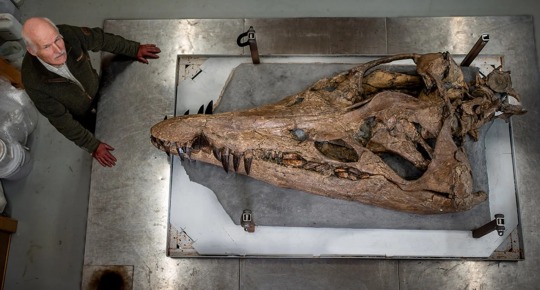


Fish heads
#pliosaur#archeology#dinosaurs#fish heads#rolly polly fish heads#marine biology#paleontology#sea monsters#sharks#prehistoric sharks#fish lizard#giant fish lizard
269 notes
·
View notes
Text

Plate 83. “Fossil corals from Central America and West Indies.” Smithsonian Institution. National Museum. Bulletin 103. 1919.
Internet Archive
490 notes
·
View notes
Text
How am I supposed to pick just one area of study like
I want to work in the ocean
I want to work with animals
I want to study cool rocks like fuck!!!
Don’t even get me started on alchemy n magic!!
#studyblr#study#school#chaotic academia#dark academia#dark acamedia#college#career#marine biology#zoology#geology#archeology#alchemy#magic
26 notes
·
View notes
Text
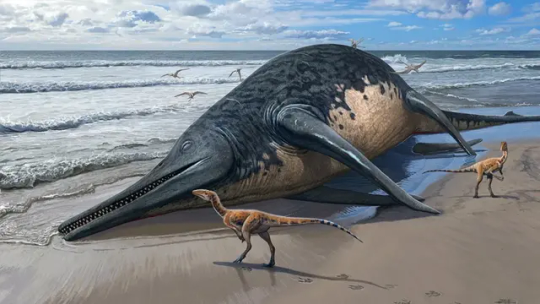
Gigantic Marine Reptile Fossil Found by 11-Year-Old Girl and Father
A massive jawbone found by a father-daughter fossil-collecting duo on a beach in Somerset along the English coast belonged to a newfound species that’s likely the largest known marine reptile to swim in Earth’s oceans.
Scientists consider the blue whale, which grows up to 110 feet (33.5 meters) long, to be the largest known animal ever to exist on the planet. But it’s possible that the 202 million-year-old reptile, known as an ichthyosaur or “fish lizard,” may have rivaled it in size.
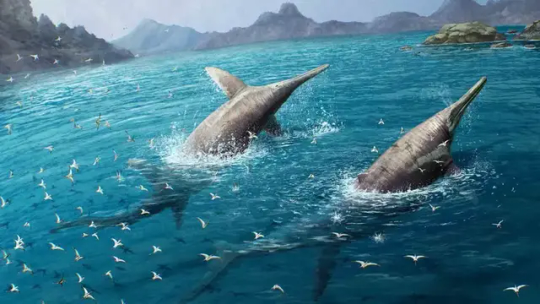
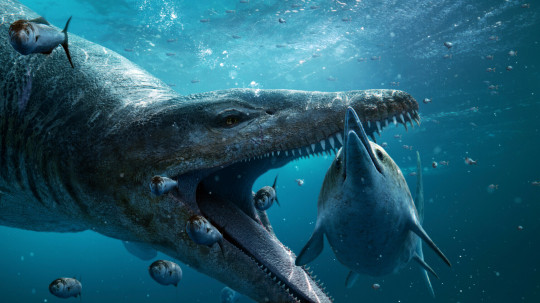
The ichthyosaur’s jawbone, or surangular, was a long, curved bone at the top of the lower jaw just behind the teeth, and it measured more than 6.5 feet (2 meters) long. Researchers believe the creature, named Ichthyotitan severnensis, or “giant fish lizard of the Severn” in Latin, was more than 82 feet (25 meters) long, or the length of two city buses.
Justin and Ruby Reynolds, who live in Braunton, England, recovered the first pieces of the jawbone in May 2020 as they looked for fossils on the beach at Blue Anchor, Somerset. Ruby, 11 at the time, spotted the first chunk of bone, and then she and her dad found additional pieces together.
By Ashley Strickland.
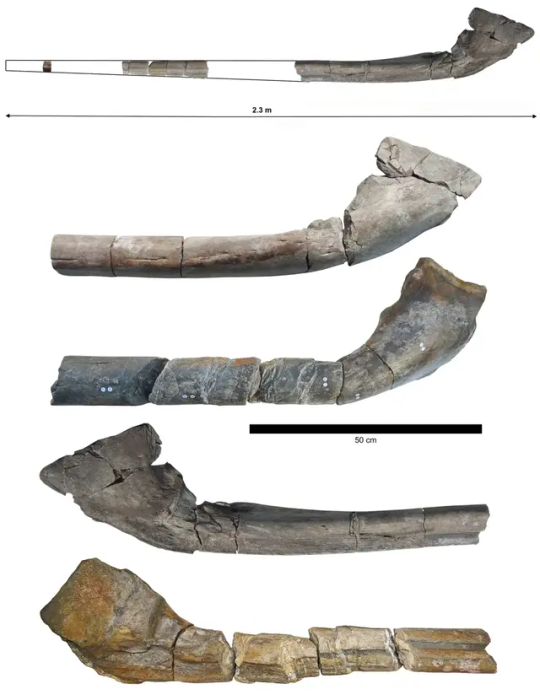
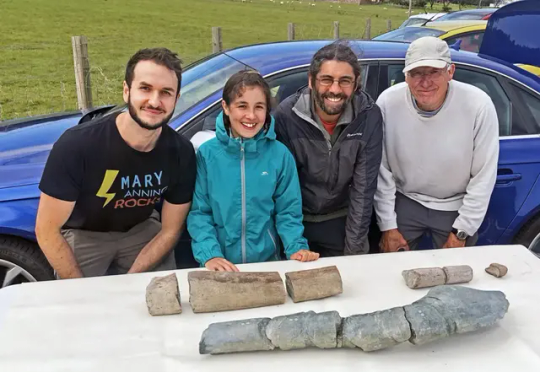
#Gigantic Marine Reptile Fossil Found by 11-Year-Old Girl and Father#Somerset#ichthyosaur#Ichthyotitan severnensis#giant fish lizard of the Severn#fish lizard#ancient artifacts#archeology#archeolgst#history#history news#ancient history#fossils
23 notes
·
View notes
Text
Jonny having mixed emotions about large bodies of water bc his unresolved trauma causes him to avoid it but good lord above he misses the sea. As someone who grew up coastal and now lives further inland in between mountains, there's always a longing to return to the sea once you've made it your home. Jonny probably already lived on or near the coast his whole life, then proceeded to spend time with pirates on a ship, an old and beautiful wooden vessel at that .... There's definitely an ache, a longing to return. To smell the salt, to feel the warm sand and the cool ocean's spray, the hear a seagull's cry or the creaking groans of a ship or crash of waves against stone......
"Old Ocean, thank you for holding me, won't be the same without you."
Holding back so many oceans themed tracks from getting in the CoCaL playlist but a few slipped through my fingers whoopsies......
#Drop in the ocean#Oh so benevolent#Plucked from the eyebrow#Of some resplenderment#Tongue tied eloquence#Dropped in the deeper end#Man overboard as sea in bewilderment#MAN OVERBOARD AT SEA IN BEWILDERMENT!!#MAN OVERBOARD AT SEA IN BEWILDERMENT!!!!!!!#MAN OVERBOARD AT SEA IN BEWILDERMENT!!!!!!!!!!!!#OVER BORDERS LOST IN THE WILDERNESS!!!#...#ahem#as you can sea I am VERY normal and sane about cosmo sheldrake's recent music#the consequences of creation and love#guys im so normal about the ocean...... im neutral about marine biology and archeology and im not projecting homesickness onto jonny i swea
13 notes
·
View notes
Note
Do you happen to know any jellyfish that live in lakes in the pnw?
I remember when I was young I went to the mountains to camp in either Washington or Oregon, and there was a lake there with tiny clear jellyfish, that didn't sting when you touch them. They were so adorable, so I figured I'd ask, it's cool if you don't know them though :3 ty!
Hi anon, are you talking about the Craspedacusta sowerbyi? It’s the only fresh water jellyfish native to North America. They seem to be found world wide from what I can find. Hope that answered your question! (Common name, though I’ve never heard them referred to as such, is the peach blossom jellyfish)

(Bonus fact but not about jellyfish: there’s a prehistoric animal called the tullymonstrum that scientists don’t know if it’s vertebrae or an invertebrate because of the fact it has signs of both. Personally I believe that it could be like a “merger” of both; meaning it’s the in between of them)
#Craspedacusta sowerbyi#jellyfish#sealife#sea life#science#biology#marine biology#marine animals#freshwater#fish#archeology#illinois#PNW#science mystery#anatomy#tully monster#tullymonstrum
48 notes
·
View notes
Text
An archaeological study of skeletons from Greenwich pensioners and the conclusions about life at sea
In 1999-2001, an archaeological survey was carried out on the south-east corner of the Greenwich Royal Hospital Burial Ground. Greenwich pensioned Sailors and Marines were buried on this burial ground from 1749-1857. During this excavation 186 graves were uncovered, but only 107 of these were excavated, the others being reburied after a short survey.

Burial ground
The excavated area once held 20,000 inhabitants who were buried there over the course of time. However, 4000 were demonstrably removed and due to construction work and the two world wars, especially the second, great damage was left behind. What is striking, however, is that the marines and normal sailors are buried in simple, rather superficial graves in a NE-SW direction and not in a W-E direction as is usual in the Christian context. Also, many graves were double-occupied, or some were buried together with their partner, which explains the 5 women.

Double interment, skeletons 3211 and 3162
Officers were buried in a specially constructed mausoleum, the existence of which can only be proven by documents. No grave goods in the form of shoe buckles, buttons or even personal objects were found. It can therefore be assumed that they were all buried in simple shrouds.
The inhabitants
The skeletons revealed that they were mainly 105 adults and 2 sub adults. 5 skeletons were identified as definitely female and two as undefined because the skeletons were too damaged. Osteological examinations revealed an age range of 60-75, with the 71-75 group being the largest. The females were between 40-50 years old. Similarly, the average height of the men was 1.60-1.74m, with only a few being between 1.74-1.80m tall. The women were between 1.40-1.55m tall.
Compared to the other hospitals in Portsmouth, Haslar and Gosport where the injured and temporarily unfit Sailors and Marines were housed, the age range was as follows. The men there, and they were all men, were between 16-50 years old, with the majority being between 20 and 30 years old. There was no great difference in size to the pensioners in Greenwich. Therefore, it can be said that the Sailor and Marine standard height was between 1.60 and 1.75m.
Nationalities
The muster rolls of the ships showed that there were a variety of nationalities on board the ships, although the majority were British, Welsh, Scottish, Irish and Islanders. The remaining part consisted of continental Europeans, and there were Prussians, North Germans, Americans, Spaniards and even Frenchmen, but also Swiss and even Africans and Indians. Now, one might think that the residents of Greenwich Hospital would be exclusively British, Welsh, Irish, Scottish and Islanders, as it was a special honour to spend one's twilight years in this hospital. But the opposite was the case: as in the muster rolls, the residents were also of different origins and the examinations of the skeletons revealed three African men. So the selection was really based on performance and injuries and not on nationality.
Trauma - everyday injuries
Almost all of the skellets had serious injuries, but these had occurred a long time ago and could therefore be traced back to everyday life on board. Typical injuries in these cases were bone fractures, especially of the lower leg. But ribs and broken noses were also the most common. a few skeletons showed full-body fractures from a fall from a high height. On one ship, this was a typical injury from a fall from the rigging. Often these ended fatally for the person who fell, but also for one or the other who was standing on the deck at the same spot and was thus killed by the falling person. Few survived and often had permanent injuries that stayed with them for the rest of their lives.

Poorly reduced but well healed nasal fracture
The fact that the legs were often broken was often due to the fact that the people slipped during a storm, fell badly and broke their legs in the process. This also often led to broken ribs and noses. The latter were also caused by scuffles between the men themselves. Interestingly, hand and finger fractures were rare among the skeletons examined. Even though one might expect this to be the case when it came to handling in the rigging or guns. On the other hand, dislocations of the arms were found in many of the examined individuals, which can be attributed to the handling of sails. Joint diseases resulting from years of toil under the most difficult conditions, such as carrying heavy loads, repetitive jerky movements, could lead to these skeletal disorders, which usually occur in old age and are therefore not uncommon.
Trauma - Battle Injuries
In this case, the injuries are much more varied and leave the victims with permanent damage and limitations.
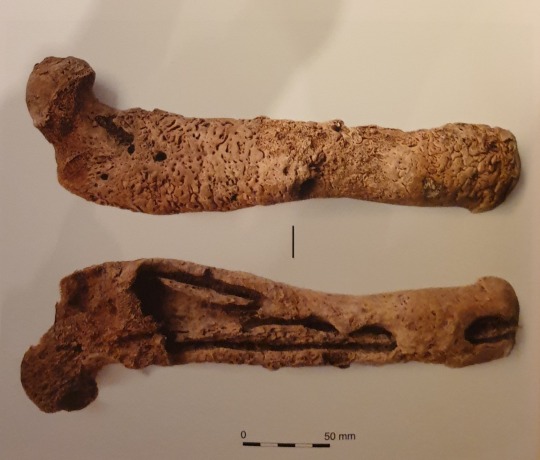
Amputation ans secondary osteomyelitis of the right femur
Skull injuries, soft tissue injuries in the form of splinter or bullet wounds, but also dislocations of extremities or even the loss of those extremities were often encountered. Musket wounds could lead to fractures, but also to more unusual injuries such as those suffered by retiree and ex-Marine Thomas Chapman. He died at the age of 72 in 1851, having suffered a gunshot wound to the face that left his lower jaw barely functional and caused severe problems with eating and speaking.

Below knee amputation of the right tibia and femur
Bone diseases
A very typical disease that many Sailors suffered from was osteoporosis and rheumatism. This was also clearly visible in these skeletons.
Infectious diseases
Tuberculosis and syphellis were the most common. The men could have contracted these diseases in the hospital, but it is most likely that they were contracted much earlier, as healing processes could be proven in various stages. Many also suffered from periostitis. Meningitis occurs after blunt injuries, bacterial infections or when osteomyelitis and bone inflammation spread to the periosteum. It severely restricts the mobility of the affected person and causes severe pain. Many also suffered from chronic sinusitis, an inflammation of the nasal sinuses, which was promoted by the constantly damp and windy weather. Since the men could not cure themselves properly and there were no antibiotics, this was a common illness, along with chronic bronchitis.
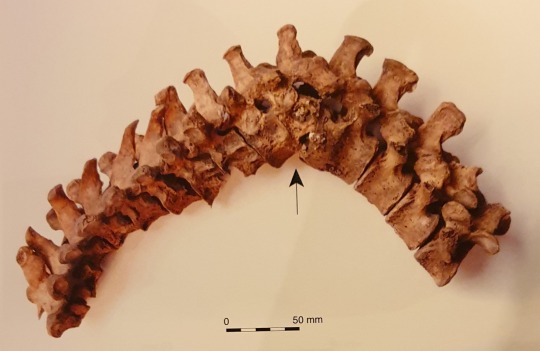
Pott's disease (tuberculosis of the spine). Note the crush fractures and the collapse of the vertebrae
Deficiency symptoms
Even when scurvy was treated, many suffered from it and it showed clearly in their bone structures, but vitamin D deficiency in childhood also led to rickets and could also cause bone softening and deformation in adulthood, which was extremely difficult for the person affected.
Surgeons interventions
There were not many Naval Surgeons, there were only 15 in 1797 and more than half of them were on half pay ashore. This, of course, led to a chronic lack of care on board the ships, which was often evident in the injuries and their healing processes. Even if there was a surgeon on board, this did not mean that the men were also well cared for, because many of the surgeons were poorly trained and had to learn their trade themselves. Many of the injuries were either badly splinted, which led to deformations in the bones, or even amputated. In this case, it only showed in the missing bones; the prostheses were not buried with them. Infectious diseases or chronic illnesses were only treated symtomatically, because either the knowledge or the means for treatment were lacking. Which is why the pensioners at Greenwich Hospital often had many illnesses and often suffered from them, but at least received some treatment. The men who were not admitted and no longer fit for service often died earlier and were very often under cared for.

Skeleton 3119 with post-mortem craniotomy
Post-mortem autopsies were even performed on four skeletons, whether for teaching purposes or for corrective reasons such as an active tuberculosis outbreak in the hospital cannot be precisely determined.
Summary
The skeletons examined, even if they were pensioners, showed the typical illnesses and injuries that a sailor could suffer at sea. Of course, the selection was quite small, but it showed well that the men, with the care they received and despite their limitations, managed to live to a fairly advanced age in a time of conflict. The abundant dataset reflects well what can often only be read in the logbooks. The origins of the men, the harsh life, the diet on board and the effects this could have on people in old age. In order to be able to provide a more accurate picture, further and more faithful studies are still needed.
#naval history#archeology#sailors and marines graves#greenwich pensioners#burial ground#18th 19th century#tw: skeleton#tw:bones
134 notes
·
View notes
Text
i’m like. 95% sure i’m getting a call tmo that i got the job
#i’m vibrating in place the company is so cool#this is the closest i would be able to get to archeology and marine biology while having an english degree
5 notes
·
View notes
Text
there are so many things I don't know shit about but I have the enthusiasm and desire to. I mean I'm not gonna research them but still
5 notes
·
View notes
Text
why everything i want to do has to be connected with geography, i cant do geography, i'm shit at it. i barely fucking pass this class every year
#first it was archeology#but i alr gave up on it cuz i cant do history either#now its fucking marine biology#this is terrible#personal
0 notes
Text
There are three types of Ukrainian artists. Those who were killed by russia, those who were repressed by russia and those whose legacy was stolen by russia. Armenian-Ukrainian artist Ivan Aivazovsky belongs to the third category. So here I present 6 fun facts about his life.
••••••••••••••••••••••••••••••••••
1. For almost an entire life he lived in the city of Feodosia in Crimea. He loved the city and was its patron, he financed museums, galleries and the development of the city.
For example, when the ancient Armenian church of Surb-Sarkis burned down, the restoration was carried out at the personal expense of Ivan Aivazovsky. From year to year, the painter donated the author's icons to the Church of St. Sergius - "Walking on Water" (1888; oil on canvas, 70 x 50), "The Last Supper" (1890; oil on canvas, 44 x 60), "The Virgin and Child ” (1891; oil on canvas; 125 x 103 cm), “Prayer for the Chalice” (1897; oil on canvas; 94 x 72).

Feodosia. Moonlit night, Ivan Aivazovsky, 1852, 29x36cm, oil on canvas, private collection
••••••••••••••••••••••••••••••••••
2. History and archeology were his huge hobbies. He even participated in archeological digs. Though he hated reading.

Chumaks leisure, Ivan Aivazovsky, 1885, oil on canvas, Belarusian National Arts Museum
••••••••••••••••••••••••••••••••••
3. He created his marine landscapes not on the coast but in his workshop from memory.

The Ninth Wave, Ivan Aivazovsky, 1850, 221x322cm, oil on canvas, State russian museum
••••••••••••••••••••••••••••••••••
4. He was the first Ukrainian artist to be exhibited in the Louvre.

View of the island of Capri, Ivan Aivazovsky, 1845, 40x57cm, oil on canvas, Kyiv National Art Gallery
••••••••••••••••••••••••••••••••••
5. Pope Gregory XVI (Gregorius PP. XVI; 1765-1846) unexpectedly wished to purchase a painting by an artist from Feodosia for the Vatican. So, at the beginning of 1841, the marinist repeated the seascape in his own way and, kneeling down, personally presented it to the Pontiff. Touched by the artist's noble gesture, in the late autumn of 1841, the governor of St. Peter personally awarded the Ukrainian Armenian with the Order of St. Sylvester and the Golden Militia.

Chaos. Creation of the world, Ivan Aivazovsky, 1841
••••••••••••••••••••••••••••••••••
In 2023, during the bloody occupation of the Ukrainian city of Kherson by russians, not only were thousands of civilians tortured and killed, but numerous museums were also robbed. Three paintings by Ivan Aivazovsky were stolen from the Kherson National Museum of Art, along with thousands of artefacts from all over the country. The stolen paintings are: "The Storm Subsides," "The Sea," and "View of the City of Odesa." Reminder: Such actions are a direct violation of the Geneva Conventions.
Support Ukraine!

In Ukrainian text states: STOLEN! Ivan Aivazovsky, View of the City of Odesa, oil on canvas
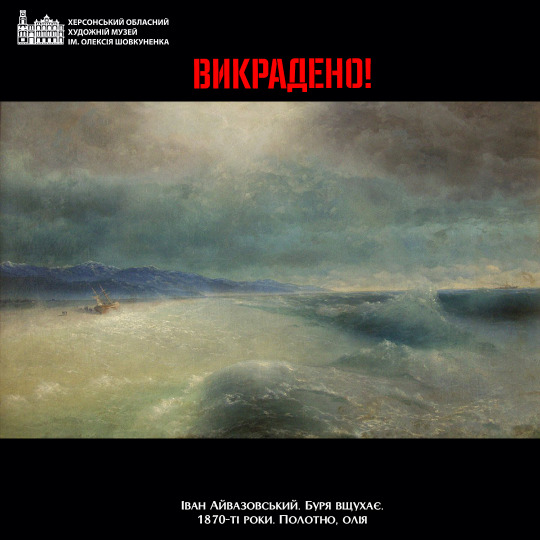
In Ukrainian text states: STOLEN! Ivan Aivazovsky, The Storm Subsides, oil on canvas
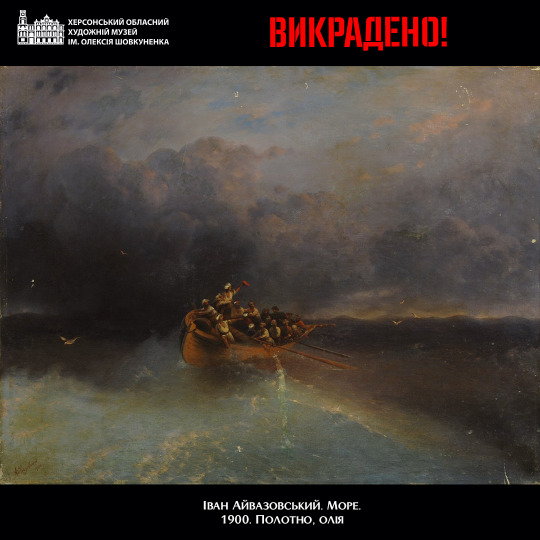
In Ukrainian text states: STOLEN! Ivan Aivazovsky, The Sea, oil on canvas
#art#art history#painting#artwork#museum#sea#ivan aivazovsky#ukrainian art#ukraine#support ukraine#russia is a terrorist state
223 notes
·
View notes
Note
What's the state of Museums regarding the Megacities in Amber Skies?
There are museums. They are generally operated by universities or other institutions. Though, a good chunk of Teleth artifacts are held by private collectors like Marin's dad. It's a bit of a class marker for the wealthy.
But there's also a healthy market for materials from the megacities. The larger a Teleth expedition, the more dangerous it is. Small dive teams have the best chance of survival, so they can only bring back what they can carry. A pound of carbonsteel is EXTREMELY valueable, as modern smiths can work with it, but cannot produce it.
Additionally, sorcerers will often pay good money for intact data storage devices from the Teleths. But you're probably not gonna be able to go take a look at the archeological server racks like a museum.
118 notes
·
View notes
Text

Diver Finds 2,500-Year-Old Disc Used by Ancient Mariners to Ward Off ‘The Evil Eye’
Artifact discovered at Palmachim Beach is a type of talisman sailors affixed to ships for good fortune, Israel Antiquities Authority says.
A rare, 2,500-year-old marble disc used by ancient mariners as a talisman has been discovered off Israel’s coast.
A lifeguard diving off Palmachim Beach discovered the artifact at the Yavne-Yam archaeological site and turned it over to researchers, the Israel Antiquities Authority said last month.
Researchers identified the object as an ancient “eye motif,” known in Greek as “ophtalmoi,” that ancient sailors affixed to their vessels in the belief it would ward off evil, the authority said in a statement.
Archaeologists are familiar with the objects from drawings on pottery, mosaics and ancient coins, and from other historical sources, said Yaakov Shitrit, the director of the authority’s Marine Archaeology Unit.
“This design was common on ships’ bows and served to protect against the evil eye and envy, aided navigation, and acted as a pair of eyes looking ahead and warning of danger,” Shitrit said in a statement. “This decoration is still common today on modern ships in Portugal, Malta, Greece, and the far east.”
The disc is flat on one side and curved on the other, has a diameter of 20 centimeters (7.8 inches), and bears traces of paint forming two circles around its center.
Sailors used lead or bronze nails to attach the discs to warships or merchant vessels, researchers said.
Only three other similar artifacts have been found in the Mediterranean Sea, even though the objects were once common. One was found off Israel’s Carmel Beach, and two were found in the wreck of an ancient merchant ship at the Tektaş Burnu archaeological site on Turkey’s coast.
The Yavne-Yam site, where the disc was found last month, was first settled during the Middle Bronze Age. Marine surveys have found shipwrecks that indicate there was intensive commercial activity in the area in ancient times, with archaeologists uncovering maritime artifacts such as anchors, weights and fishing gear.
Researchers have also found items that were used on ships including a lead cooking oven, grinding stones, stone bowls, storage jars and cooking pots.
The artifacts date a stretch of history covering the Late Bronze Age, and the Persian, Hellenistic, Roman and Byzantine periods, the Israel Antiquities Authority said.
#Diver Finds 2500-Year-Old Disc Used by Ancient Mariners to Ward Off ‘The Evil Eye’#2500-year-old marble dis#talisman#marble#marble disk#ancient artifacts#archeology#archeolgst#history#history news#ancient history#ancient culture#ancient civilizations#bronze age
43 notes
·
View notes
Text
an abridged list of items of archeological significance recovered by divers in Beleriand
read on ao3
1: Partial skeleton, clear draconian origin. Remarkably well preserved; though centuries old, fragments of the skull, two vertebrae, and a rib had sunk to the bottom of the ocean and been preserved in pelagic red clay. Though not enough bone remains to reproduce the shape of the head with any degree of certainty, we can now confirm the size of the head would have been at a minimum 4.6 meters wide and 5.8 meters long. One particularly well preserved tooth was measured at 48.5 cm in length.
See addendum A for detailed sketches of the recovered skeleton.
2: Arrowhead, found near the eye socket of the aforementioned draconian skull. Flint. Simple design and choice of material indicates a probable human origin.
3-16: Swords. Hard iron, highly degraded due marine corrosion. These are made in a one handed style, curved as sabres; no decoration survives.
17-23: Swords. Steel, somewhat degraded due to marine corrosion. These are made in a two-handed style, and are much larger than the previous set. 18 and 22 retain decorative elements on the pommels and cross guards. Cross-hatching on 18 may have once depicted a star or flower. The pommel of 22 is set with a red gem.
24: Sword. Unknown material (footnote 1), which shows no sign of degradation. Researchers onsite initially assessed it as having no archeological significance due to its appearance; it was, however, found buried underneath three meters of marine sediment, embedded in copper helmet and skull (25). The site had been undisturbed for longe enough for significant vegetation to have grown over it; we are forced to conclude 24 could not have been placed there recently. Still, the age of the weapon remains unknown and hotly debated among field researchers.
This is a two-handed great-sword measuring 2.1 meters in length and weighing 4 kg. It is heavily ornamented. The pommel is decorated with an amber set in gold, surrounded by concentric golden circles and protruding rays; it appears to depict a rising sun. The blade itself is engraved, depicting eagles in flight. It remains extraordinarily sharp.
25: Partial skeleton; skull, spinal column, pelvis. The weight of the skull and distinctive jaw shape indicate orcish origin. The skull was found still encased in a copper helmet, highly degraded due to marine corrosion. Cause of death is plainly trauma to the top of the skull, which, along with the helmet, had been pierced by the great-sword (24) described above.
26: Full skeleton. Elven origin. Most probably female and roughly 185 cm in height. Based on placement and position of the body (footnote 2) it appears to have been laid to rest before any battle had taken place on the site. Cause of death appears to be blunt force trauma to the chest, with several ribs broken in at an angle that would have pierced the lungs. The body was buried wearing jewelry (4 sets of silver earrings, silver lip ring, copper circlet, two silver rings worn on the fingers, copper ankle-bracelets) and with a great-sword laid across the chest.
27: Full canine skeleton. Size and shape indicate a medium herding dog, perhaps somewhat resembling a collie. Osteoarthritis and severe hip dysplasia observed on the skeleton indicate the specimen had likely been of advanced age at time of death; otherwise no cause of death could be determined. Placement of the bones indicates that the body has been tightly wrapped in a now-degraded piece of fabric (such as a towel or blanket) when buried. A silver flower charm, which may have once been attached to a leather or rope collar, was found by the neck.
Notably, it appears to have been buried with the elven remains described above (26). Placement of the body indicates that the graves were not dug simultaneously; it is our opinion that another party returned to bury 27 alongside 26.
28-29: Two full skeletons. Orcish origin. One (28) is most probably male, roughly 174 cm in height. Cause of death appears to be blunt force trauma to the head. The second (29) is roughly 171 cm in height; bone structure and degradation makes sex impossible to determine with any degree of certainty. Though the bones of this skeleton show no damage, an elven knife (30) was found inside the ribcage. It is our opinion that it is likely the body had died as a result of the injuries inflicted by the blade, and that the blade, buried inside the body, likely had gone unnoticed by the party responsible for burial.
Placement of the bones indicates a shared burial; the two skeletons had been laid side-by-side, with their hands placed on top of each other.
30: Obsidian knife, 12 cm in length and 4 cm in width. Found resting inside the ribcage of an orcish skeleton (29). It is engraved with writing in Sindarin. Only one word, believed to be “aurë” (S. day ) is still legible.
31: Bone fragment: partial right radius with attached carpal fragments. The bone is damaged on both ends. On the medial end, bone has been severed four inches above the wrist, likely while the body had still been living: splinter patterns indicate a relatively crude, blunt weapon, implying the amputation had relied largely on brute force. On the lateral end, adjacent to the remaining carpal fragments, the bone appears to have been drilled into. The drilling indicates a highly precise, surgical procedure; the drilling site would have been very near vital blood vessels, and a high level of skill would have been necessary to avoid killing the subject. When the bone fragment was found, a thin rod of unknown metal had been driven through the hole, attached to an eight-link chain; the bone had broken during extraction attempts and detached from the rod. Neither the rod nor the chain could be removed from rock formations on the ocean floor by divers.
The bone is unusually large (radial length estimated at minimum 38cm, though exact measurement impossible due to degradation of bone). Size and elongated shape indicate a probable elven origin, though further testing may be needed to confirm. Age and damage of the sample have made attempts at DNA extraction unviable. (footnote 3)
32: Chiseled stone toy. The toy depicts a humanoid figure consisting of two spheres stacked atop each other. A smiling face with upturned lips and large eyes is carved into the top circle; indentations as feet have been made on the bottom. Two prongs protrude from the head; these may be meant to represent ears, horns, or hair.
This figure has proved particularly hard to categorize. The protruding ears may indicate an elven origin. The relative crudeness of the features of the face suggests orcish make. The style of the carving, meanwhile, is reminiscent of artifacts recovered from contemporary human settlements.
(1) Field tests inconclusive; currently awaiting results of off-site testing.
(2) Found supine with arms crossed over chest.
(3) That any bone should remain intact for years (let alone centuries) in such an environment is highly unusual. Further study of this phenomenon is necessary; at present we can only hypothesize the cause to be some form of hyper-preservation common in elven remains, or perhaps an effect of the unknown black metal.
268 notes
·
View notes